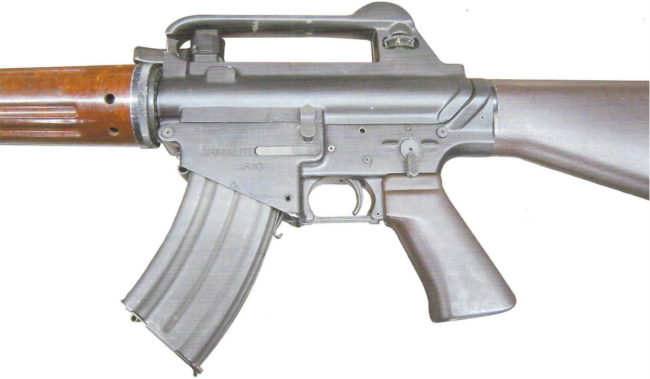The Armalite AR-10 rifle was designed in USA between 1954 and 1956 as a military rifle, using advanced aircraft industry materials and technologies, primarily aluminum alloys and plastics. It was primarily designed by the Eugene Stoner, a chief engineer of the Armalite division of the Fairchild Engine and Airplane Corporation.
In 1956 the new AR-10 rifle was tested by US military at the Springfield armory, as a potential new US army rifle, but it was rejected as not sufficiently mature, compared to the T44 (future M14) and T48 (FN FAL) rifles. Besides some design and manufacturing flaws, the AR-10 was not favored by Springfield Armory personnel as it posed some challenges to their own in-house designed rifle, the T44.

The early Armalite AR-10 rifle, made in the USA. It featured a massive muzzle brake / flash hider and its gas tube was located to the left of the barrel. Photo from US military test report
With little chances of adoption of an AR-10 on its home soil, in 1957 Fairchild sold manufacturing and worldwide sale rights to the Artillerie-Inrichtingen in Netherlands, which, in turn, hoped to sell the rifle to the Dutch army and other European and 3rd-world militaries. However, these plans generally failed, despite the fact that Dutch-made Armalite AR-10 rifles were extensively tested in Austria, Netherlands, West Germany and Finland. In the last case, some AR-10 rifles were converted to the 7.62x39mm Soviet cartridge, as requested by the Finnish military.

Close-up view to the AR-10 rifle, chambered for the Soviet 7.62x39mm cartridge and supplied to the Finnish assault rifle trials in late 1950s.
There were few minor sales in late fifties and early sixties, and the only major buyers of the Armalite AR-10 were Portugal and Sudan. It is believed that Artillerie-Inrichtingen produced no more than ten thousands of AR-10 rifles in total, before closing its production line soon after the FN FAL was adopted by Dutch army in early sixties.
Besides the basic military AR-10 automatic rifle, an individual weapon, the Artillerie-Inrichtingen also designed several experimental versions such as a carbine and the light machine guns. AR-10 machine guns were either magazine-fed or featured dual feed system (magazine or belt) and featured removable barrels.
The most important role of the Armalite AR-10 rifle is that it served as a base for development of a slightly smaller and lighter Armalite AR-15 / US M16 rifle, which then became one of the most successful military rifles of the twentieth century.
In mid-1980s the Armalite brand was resurrected by the US-based Eagle Arms co, and a semi-automatic Armalite AR-10B rifles entered production for civilian markets. These newly made AR-10 semi-automatic rifles are produced to this day in a wide variety of versions for sporting and law enforcement use.
The original Armalite AR-10 automatic rifle is a gas operated weapon that uses Stoner-designed direct gas impingement system. Powder gases are fed from the barrel via the long gas tube back to the receiver. The rear end of the gas tube enters the gas key on the bolt carrier, which then directs hot gases into the cavity, formed by the bolt carrier and bolt shank. Expanding powder gases then force the bolt carrier back against the bolt, to cycle the action. Locking is achieved by the rotating bolt with seven radial lugs that engages the barrel extension. Return spring extends back from the receiver and into the shoulder stock. Charging handle is located above the receiver, inside a “window” formed by the integral carrying handle. Both upper and lower receivers are made from aluminum alloy forgings and are connected by the two cross-pins. Hammer-fired trigger unit offers single shots and full-automatic fire. Safety/fire selector lever is located on the left side of the gun. Rifle uses detachable box magazines, made from aluminum alloy, with 20-round capacity. To facilitate faster reloads, a bolt hold-open mechanism is built into the lower receiver. Shoulder stock, pistol grip and forend are usually made from the plastic. Iron sights feature and adjustable rear diopter sight, built into the charging handle.
Caliber: 7,62mm NATO (7.62x51mm)
Action: Gas operated, rotating bolt
Length : 1016 mm
Barrel Length: 508 mm
Weight: 4.31 kg empty, without magazine and sling
Magazine: 20 rounds
Rate of fire: 700 rounds per minute (original military version)